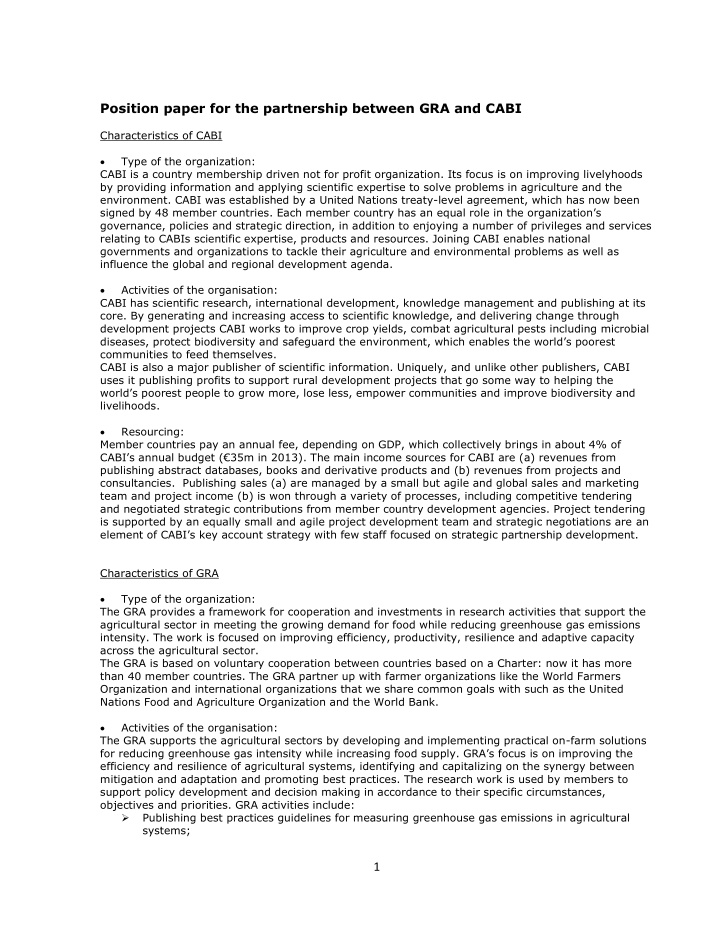



Position paper for the partnership between GRA and CABI Characteristics of CABI Type of the organization: CABI is a country membership driven not for profit organization. Its focus is on improving livelyhoods by providing information and applying scientific expertise to solve problems in agriculture and the environment. CABI was established by a United Nations treaty-level agreement, which has now been signed by 48 member countries . Each member country has an equal role in the organization’s governance, policies and strategic direction, in addition to enjoying a number of privileges and services relating to CABIs scientific expertise, products and resources. Joining CABI enables national governments and organizations to tackle their agriculture and environmental problems as well as influence the global and regional development agenda. Activities of the organisation: CABI has scientific research, international development, knowledge management and publishing at its core. By generating and increasing access to scientific knowledge, and delivering change through development projects CABI works to improve crop yields, combat agricultural pests including microbial diseases, protect biodiversity and safeguard the environment, which enables the world’s poorest communities to feed themselves. CABI is also a major publisher of scientific information. Uniquely, and unlike other publishers, CABI uses it publishing profits to support rural development projects that go some way to helping the world’s poorest people to grow more, lose less, empower communities and improve biodiversity and livelihoods. Resourcing: Member countries pay an annual fee, depending on GDP, which collectively brings in about 4% of CABI’s annual budget (€35m in 2013) . The main income sources for CABI are (a) revenues from publishing abstract databases, books and derivative products and (b) revenues from projects and consultancies. Publishing sales (a) are managed by a small but agile and global sales and marketing team and project income (b) is won through a variety of processes, including competitive tendering and negotiated strategic contributions from member country development agencies. Project tendering is supported by an equally small and agile project development team and strategic negotiations are an element of CABI’s key account strategy with few staff focused on strategic partnership development. Characteristics of GRA Type of the organization: The GRA provides a framework for cooperation and investments in research activities that support the agricultural sector in meeting the growing demand for food while reducing greenhouse gas emissions intensity. The work is focused on improving efficiency, productivity, resilience and adaptive capacity across the agricultural sector. The GRA is based on voluntary cooperation between countries based on a Charter: now it has more than 40 member countries. The GRA partner up with farmer organizations like the World Farmers Organization and international organizations that we share common goals with such as the United Nations Food and Agriculture Organization and the World Bank. Activities of the organisation: The GRA supports the agricultural sectors by developing and implementing practical on-farm solutions for reducing greenhouse gas intensity while increasing food supply. GRA’s focus is on improving the efficiency and resilience of agricultural systems, identifying and capitalizing on the synergy between mitigation and adaptation and promoting best practices. The research work is used by members to support policy development and decision making in accordance to their specific circumstances, objectives and priorities. GRA activities include: Publishing best practices guidelines for measuring greenhouse gas emissions in agricultural systems; 1
Synthesizing research results; Developing mitigation and adaptation solutions; Collaborating in multi-country and multi-partner research projects; Supporting literature and research databases; Undertaking capacity and capability building work, particularly in developing countries. Resourcing: Member countries do not pay a fee, hence there is no “core budget” for GRA activities. Because it’s a voluntary cooperation, member countries supply national resources to enable their researchers, policy officials and others participants from its country to participate within the activities. E.g. a country supplies budget to enable less wealthy countries to participate within GRA activities. Some countries provide funding through research programs like the Borlaugh Fellowship. Mutual benefits of partnering 1. CABI and GRA are both member country driven organizations and according to the world map each outreach can strongly be increased when CABI and GRA partner up (Figure 1); 2. CABI’s role in dissemination and validation of research outputs in combination with knowledge transfer to farmers is complementary to GRA’s role in research development and collaboration; 3. GRA’s research projects and (entry to) databases can increase the body of knowledge CABI can publish; 4. CABI and GRA together can increase the impact and reach of the knowledge that circulates within agricultural sectors and their stakeholders. Implementing partnership When partners, CABI and GRA can illustrate added value in the following projects/activities: Explore the number of databases GRA-researchers have entry to and bring this in into CABI’s regular publishing activities leading to enriched existing products and/or new products, ensuring wider dissemination and use of GRA related research publications and models; Explore how CABI’s network and processes, that facilitate knowledge transfer to farmers, can be used by the GRA research groups to transfer the ‘GRA knowledge’ to the intended ultimate beneficiaries of GRA’s research, the farmers; Design a joint program on a relevant issue (to be determined) including knowledge coding, knowledge development, knowledge transfer and knowledge utilization; Facilitate exchange between CABI and GRA membership and explore new scenarios for the combined influence of CABI and GRA on agriculture,. Janny Vos, CABI Sjoerd Croqué, GRA September 2014 ========== 2
Figure 1: World map showing member countries from CABI as well as from the GRA. 3
Recommend
More recommend